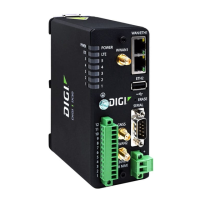Services Location information
IX30 User Guide
536
5. Set the type of location source to user_defined:
(config service location source 0)> type user_defined
(config service location source 0)>
6. Set the latitude of the device:
(config service location source 0 coordinates latitude int
(config service location source 0)>
where int is any integer between -90 and 90, with up to six decimal places.
7. Set the longitude of the device:
(config service location source 0 coordinates longitude int
(config service location source 0)>
where int is any integer between -180 and 180, with up to six decimal places.
8. Set the altitude of the device:
(config service location source 0 coordinates altitude alt
(config service location source 0)>
Where alt is an integer followed by m or km, for example, 100m or 1km.
9. Save the configuration and apply the change:
(config)> save
Configuration saved.
>
10. Type exit to exit the Admin CLI.
Depending on your device configuration, you may be presented with an Access selection
menu. Type quit to disconnect from the device.
Configure the device to accept location messages from external
sources
You can configure the IX30 device to accept NMEA and TAIP messages from external sources. For
example, location-enabled devices connected to the IX30 device can forward their location
information to the device, and then the IX30 device can serve as a central repository for this location
information and forward it to a remote host. See Forward location information to a remote host for
information about configuring the IX30 device to forward location messages.
This procedure configures a UDP port on the IX30 device that will be used to listen for incoming
messages.
Required configuration items
n
The location server must be enabled.
n
UDP port that the IX30 device will listen to for incoming location messages.
n
Access control list configuration to provide access to the port through the firewall.
To configure the device to accept location messages from external sources:
Web

